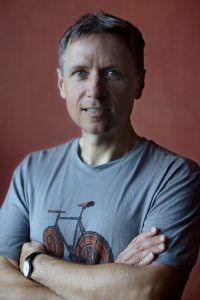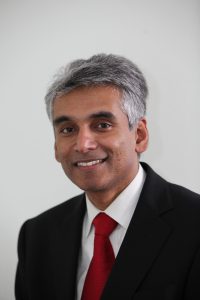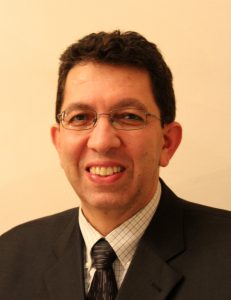Professor Raffaello D’Andrea
Institute for Dynamic Systems and ControL
Swiss Federal Institute of Technology (ETH), Switzerland
 BIO: Spanning academia, business and the arts, Raffaello D’Andrea’s career is built on his ability to bridge theory and practice. At the Swiss Federal Institute of Technology (ETH) in Zurich, his research redefines the capabilities of autonomous systems.
BIO: Spanning academia, business and the arts, Raffaello D’Andrea’s career is built on his ability to bridge theory and practice. At the Swiss Federal Institute of Technology (ETH) in Zurich, his research redefines the capabilities of autonomous systems.
D’Andrea is co-founder of Kiva Systems (acquired by Amazon in 2012, and now operating as Amazon Robotics), a robotics and logistics company that develops and deploys intelligent automated warehouse systems. He was the faculty advisor and system architect of the Cornell Robot Soccer Team, four-time world champions at the international RoboCup competition. With his startup, Verity Studios, he recently created the flying machine design and choreography for Cirque du Soleil’s Paramour on Broadway.
In addition, he is a new media artist with exhibitions at various international venues, including the Venice Biennale, the FRAC Centre and the National Gallery of Canada. Other creations and projects include the Flying Machine Arena, the Distributed Flight Array, the Balancing Cube, Cubli, Flight Assembled Architecture, the Blind Juggler, the Robotic Chair and RoboEarth. His TED talks, viewed more than 10 million times, have inspired a generation to pursue engineering, robotics, and computer science.
Research in the Flying Machine Arena
ABSTRACT: In this talk I will discuss research in the Flying Machine Arena at ETH Zurich. The Flying Machine Arena (FMA) is a portable space devoted to autonomous flight. Measuring up to 10 x 10 x 10 meters, it consists of a high-precision motion capture system, a wireless communication network, and custom software executing sophisticated algorithms for estimation and control. Various objects can fly in the FMA, but the machine of choice is the quadrocopter due to its agility, its mechanical simplicity and robustness, and its ability to hover. Furthermore, the quadrocopter is a great platform for research in adaptation and learning: it has well understood, low order first-principle models near hover, but is difficult to characterize when performing high-speed maneuvers due to complex aerodynamic effects. We cope with this difficulty with algorithms that use first-principle models to roughly determine what a vehicle should do to perform a given task, and then learn and adapt based on flight data.
Professor Visakan Kadirkamanathan
Department of Automatic Control and Systems Engineering
the University of Sheffield, United Kingdom
 BIO: Visakan Kadirkamanathan obtained his B.A in Electrical and Information Sciences at Cambridge University Engineering Department and went on to complete his PhD in Information Engineering at the same institution. He was appointed Lecturer at the Department of Automatic Control & Systems Engineering at the University of Sheffield in 1993 and is now Professor of Signal and Information Processing. He was also the Head of Department from 2009-2014. He holds the position of a Guest Professor of Chongqing University, China and a Visiting Professor at the Instituto Techologico de Aeronautica, Brazil.
BIO: Visakan Kadirkamanathan obtained his B.A in Electrical and Information Sciences at Cambridge University Engineering Department and went on to complete his PhD in Information Engineering at the same institution. He was appointed Lecturer at the Department of Automatic Control & Systems Engineering at the University of Sheffield in 1993 and is now Professor of Signal and Information Processing. He was also the Head of Department from 2009-2014. He holds the position of a Guest Professor of Chongqing University, China and a Visiting Professor at the Instituto Techologico de Aeronautica, Brazil.
He is currently the Director of the Rolls-Royce University Technology Centre for Control and Monitoring Systems Engineering at Sheffield since 2012 and a Founder Member of the University Centre for Signal Processing and Complex Systems. His research interests are in the area of modeling and identification of complex dynamic systems and signal processing applications in aerospace, biomedical and social sciences. He was a recipient of the PNAS Cozzarelli Prize in 2013 as co-author of a paper on modelling the dynamics of conflicts. He is also the Editor-in-Chief of the International Journal of Systems Science.
Modelling, Estimation and Identification of Spatio-Temporal and Multiscale Systems
ABSTRACT: Advances in sensing and data acquisition systems in a multitude of domains, combined with information networks, have expanded the scope of monitoring and characterising dynamic behaviour of systems in many applications. The data and signals that are acquired from the system are typically multichannel, multivariate and in some cases, spatially organized. The focus of the talk is on systems from which spatio-temporal data are obtained. The talk will begin with a background to estimation and system identification giving details of the methods used. This is followed by a selection of problems that are characterised by spatio-temporal processes that set the scene for the classes of problems being considered. Specifically, it highlights three case studies which serves to illustrate the three different spatio-temporal models used in estimation and identification. The first case study is from the engineering domain with application to wind turbines. The problem of estimating the wind velocity and pressure fields from LIDAR-type sensor measurements is considered. The second case study is from the healthcare domain with application to neuroscience. The problem of developing a patient-specific model from intracranial EEG array signal that can characterize changes during epilepsy is considered. Finally, the third case study is from the social science domain with application to conflict modelling. The problem of developing a predictive model of the dynamics of conflicts from event data is addressed. The talk concludes with the challenges in spatio-temporal modeling.
Professor Marios Polycarpou
KIOS Center for Intelligent Systems and Networks
University of Cyprus, cyprus
 BIO: Marios Polycarpou is a Professor of Electrical and Computer Engineering and the Director of the KIOS Research Center for Intelligent Systems and Networks at the University of Cyprus. He received undergraduate degrees in Computer Science and in Electrical Engineering, both from Rice University, USA in 1987, and the M.S. and Ph.D. degrees in Electrical Engineering from the University of Southern California, in 1989 and 1992 respectively. His teaching and research interests are in intelligent systems and networks, adaptive and cooperative control systems, computational intelligence, fault diagnosis and distributed agents. Dr. Polycarpou has published more than 300 articles in refereed journals, edited books and refereed conference proceedings, and co-authored 7 books. He is also the holder of 6 patents.
BIO: Marios Polycarpou is a Professor of Electrical and Computer Engineering and the Director of the KIOS Research Center for Intelligent Systems and Networks at the University of Cyprus. He received undergraduate degrees in Computer Science and in Electrical Engineering, both from Rice University, USA in 1987, and the M.S. and Ph.D. degrees in Electrical Engineering from the University of Southern California, in 1989 and 1992 respectively. His teaching and research interests are in intelligent systems and networks, adaptive and cooperative control systems, computational intelligence, fault diagnosis and distributed agents. Dr. Polycarpou has published more than 300 articles in refereed journals, edited books and refereed conference proceedings, and co-authored 7 books. He is also the holder of 6 patents.
Prof. Polycarpou is a Fellow of IEEE and IFAC, and past IEEE Distinguished Lecturer of Computational Intelligence. He is the recipient of the 2016 IEEE Neural Networks Pioneer Award and the 2014 Best Paper Award for the journal Building and Environment (Elsevier). He has served as the President of the IEEE Computational Intelligence Society (2012-2013), and as the Editor-in-Chief of the IEEE Transactions on Neural Networks and Learning Systems (2004-2010). He is currently the Vice President of the European Control Association (EUCA). Prof. Polycarpou has participated in more than 60 research projects/grants, funded by several agencies and industry in Europe and the United States, including the prestigious European Research Council (ERC) Advanced Grant.
Distributed Fault Diagnosis of Interconnected Cyber-Physical Systems
ABSTRACT: The emergence of interconnected cyber-physical systems and sensor/actuator networks has given rise to advanced automation applications, where a large amount of sensor data is collected and processed in order to make suitable real-time decisions and to achieve the desired control objectives. However, in situations where some components behave abnormally or become faulty, this may lead to serious degradation in performance or even to catastrophic system failures, especially due to cascaded effects of the interconnected subsystems. The goal of this presentation is to motivate the need for health monitoring, fault diagnosis and security of interconnected cyber-physical systems and to provide a methodology for designing and analyzing fault-tolerant cyber-physical systems with complex nonlinear dynamics. Various detection, isolation and accommodation algorithms will be presented and illustrated, and directions for future research will be discussed.
